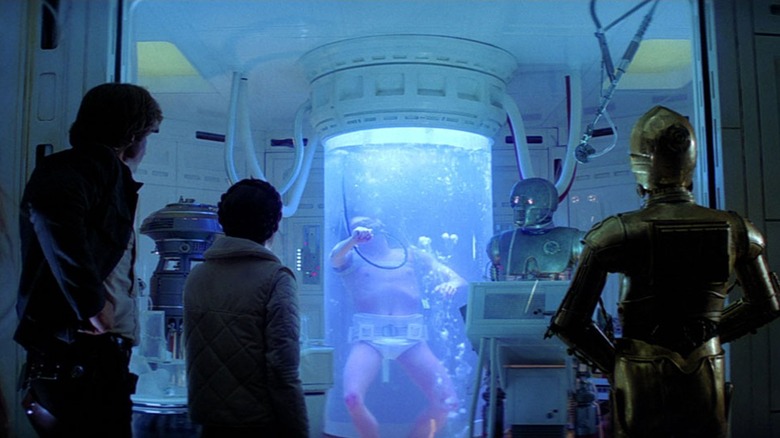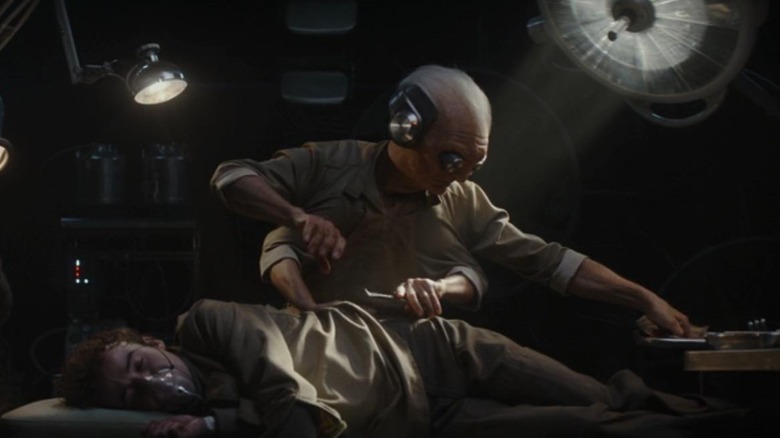Star Wars: How Do Bacta Tanks Actually Work?
Burned? Concussed? If you're a denizen of the "Star Wars" galaxy, these ailments all have the same miracle cure: a dip in the bacta tank. First introduced in "The Empire Strikes Back" when Luke returns to the rebels' Hoth base gravely injured, bacta has since become one of the most ubiquitous pieces of "Star Wars" technology. But how does it actually work?
In essence, bacta is a synthetically created microbiome. The clear substance seen in bacta tanks is made by pairing a particular strain of barley called Vratixia renanicus with a breed of bacteria called alazhi. These two core ingredients are mixed with a chemical compound and a preexisting liquid called ambori. This combination fosters a specific kind of microbiotic growth, which has incredible healing properties when damaged lifeforms are submerged in it.
The exact mechanics of bacta remain a mystery, mostly because it's simply not real. But as sci-fi tech goes, it's actually pretty simple. Just as bacteria within the human body help us perform necessary life functions, so do the fantastical bacteria proliferated in bacta have medicinal effects on living tissue. Full submergence in the substance enacts a rapid healing process, whereby anything from minor burns and scratches to broken bones and major internal injuries are quickly repaired. But, of course, not everyone in the "Star Wars" galaxy can afford bacta treatment, and it wasn't always available.
A brief history of bacta in Star Wars
Considering how much ancient history there is in the "Star Wars" universe, bacta is a relatively modern innovation. Its production on the planet Thyferra dates back a long time, but it wasn't until later in the High Republic era — a couple hundred years before the beginning of the prequel trilogy — that it started being mass-produced across the galaxy and used as a widespread medical technology.
The High Republic novel "Light of the Jedi" details the efforts on Hetzal Prime, a major agricultural world, to manufacture bacta en masse. However, such methods took tiem to refine and proliferate. By the time that the Clone Wars began, though, bacta production had become much easier and more commonplace, and the republic used bacta tanks frequently to treat wounded clones and Jedi.
We see private bacta tanks throughout the original trilogy era and in the years following "Return of the Jedi." The rebels have access to the devices on their main ships and within their primary bases, like on Hoth. In "The Book of Boba Fett," the eponymous bounty hunter also has a tank in his Tatooine palace — a home he steals from the late Jabba the Hutt, suggesting the tank belonged to the mobster to begin with. While bacta tanks are common in these stories, they aren't so universal that just anyone can use them.
Bacta never fully replaces more traditional medicine
It makes sense that an intergalactic gangster like Jabba or the Rebel Alliance's leaders would be able to get their hands on private bacta tanks. However, in many corners of the galaxy, less advanced forms of medicine remain the primary method of care. We see this in "Andor" Season 1 after the rebel raid on Aldhani, when Karis Nemik (Alex Lawther) is critically wounded and brought to a doctor on a remote farming world. Out there, in a rural, hidden corner of the galaxy away from Imperial eyes, it's good old-fashioned anesthesia and surgery that reigns supreme. Perhaps if the country doctor had access to a bacta tank, Nemik would have survived.
There are also some injuries that bacta seems incapable of curing. For instance, in "Star Wars Rebels" Season 2, Jedi Knight Kanan Jarrus is blinded. He eventually learns to see through the Force, but it takes a long time. Since Kanan is stationed with one of the Rebel Alliance's biggest factions at the time, you'd think he would have been able to take bacta treatment if it could have healed his eyes. Instead, he's left to his own devices.
Through stories like these, "Star Wars" has managed to stop bacta from becoming too much of a catch-all fix. It isn't always available or helpful, but it's certainly the most reliable medical approach in the galaxy.


